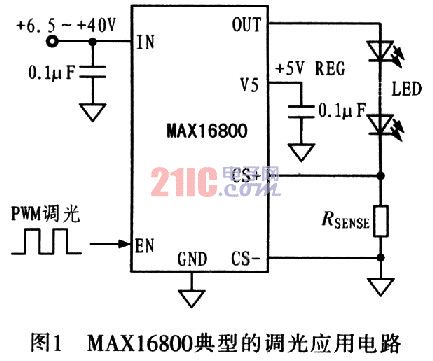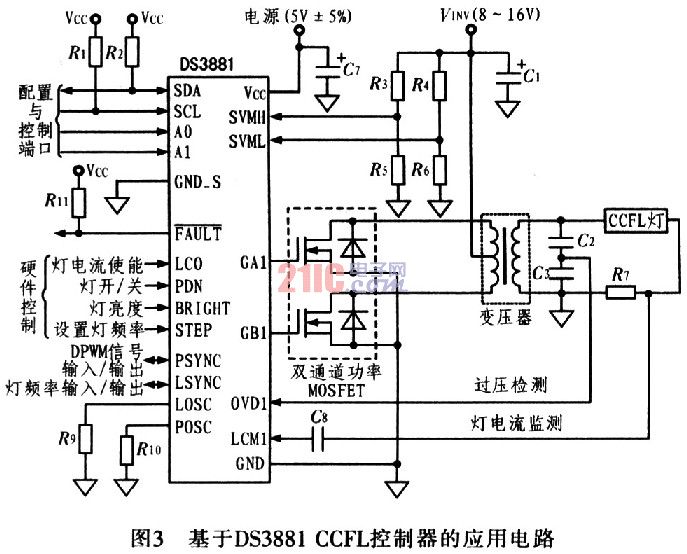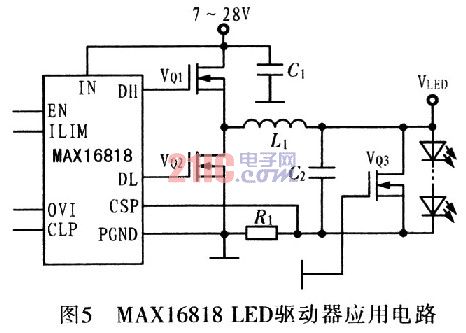Abstract: Most of the cars use LEDs and CCFLs as backlights. Both solutions require special power supplies. The power supply scheme of LED and CCFL light source is designed, and various specific application circuits such as automobile interior illumination, background display and external illumination are given, which can be used in the interior and exterior illumination of automobiles. These automotive lighting power application design circuits can effectively dissipate heat and save design costs.
Keywords: MAXl6805
This article refers to the address: http://
Light-emitting diodes (LEDs) and cold cathode fluorescent lamps (CCFLs) are becoming common light sources for automotive lighting. The key advantages of these sources are their long life and higher efficiency. The typical life of incandescent lamps is 10 000 h, while fluorescent lamps can reach 50 000 h and LEDs can reach 100 000 h. Extended service life increases reliability, reduces maintenance and reduces service costs. LEDs also feature low operating voltage, low electromagnetic radiation, high mechanical stress resistance, flexible shape design, wide operating temperature range and wide brightness adjustment range. With the development of LED technology, the trend of replacing other power supply technologies is more obvious. However, in the current application, CCFL still occupies certain application fields, such as large-screen backlights and those that require high-power unfocused light sources.
CCFLs and LED light sources require an appropriate power supply, and different technologies have different special requirements, and the power supply must provide special applications and functions. Here, a variety of power solutions are provided for LED and CCFL sources for different automotive interior and exterior lighting.
1 Automotive interior lighting Automotive interior lighting applications include dashboard and dashboard backlighting, ceiling and map lights, door openers mounted on doors or on the body, and backlighting. LEDs can be used as a light source for all internal lighting applications. Map lights and ceiling lights typically use a high-brightness LED. Dashboards and door lights typically require more than one LED in series. The serial connection helps to avoid current (corresponding color) mismatch of different LEDs. All applications require a constant current source with integrated brightness adjustment.
1.1 Automotive interior lighting design based on MAXl6800 Figure 1 shows the typical dimming application circuit of MAXl6800. With a high input voltage range (up to 40 V), the MAXl6800 can be directly connected to a car battery without the need for a protection device, which is typically used to withstand surge voltages caused by battery load changes. The MAxl6800 is capable of providing a constant current to the LED, and the current value can be set by the current-sense resistor RSENSE in series with the LED. In order to improve the current setting accuracy and improve the suppression of external noise, the MAXl6800 uses a differential current sense input method.

The chromaticity of an LED changes with its current, so the best way to adjust the brightness of an LED is to chop a fixed current through a pulse-width modulated (PWM) signal instead of changing the actual amplitude of the current. The MAXl6800 adjusts LED brightness by applying a PWM signal to the device's enable input pin. The current through the LED is turned on and off according to the frequency of the PWM signal.
Electromagnetic interference (EMI) suppression is very important in automotive applications, and this design requirement is as important as not generating EMI. When the LED current is turned on and off, EMI radiation is generated anyway. Therefore, to reduce EMI during PWM dimming, the MAXl6800 integrates a waveform shaping circuit to smooth the edges of the switching signal.
1.2 Automotive interior lighting design based on MAX16805/MAXl6806 Since many lighting systems do not have a microcontroller to generate PWM dimming signals, the MAXl6805/MAXl6806 LED drivers can be used. Both devices generate an internally generated PWM signal that is set by an external analog voltage applied to the DIM input pin. When not using analog dimming, the MAX16806 has a switch input (SW) that not only detects the switch state, but also has a debounce function that provides a wet current to the switch. Figure 2 shows the typical application circuit of the MAX16805/MAXl6806.

In automotive lighting applications, the temperature of the LEDs must be closely monitored, which is especially important for systems that are compact, especially in systems with poor heat dissipation. Overheating of the LEDs reduces the useful life of the LEDs, thereby diminishing the key advantages of such sources. However, by reducing the brightness of the LEDs for a short period of time, overheating can be avoided in most applications. The MAXl6806 therefore provides an input for the external temperature sensor. When overheating is detected, the device can turn down the brightness until the temperature returns to an acceptable range. The temperature and brightness adjustment thresholds can be programmed via the serial port and stored in the EEPROM. This feature eliminates the need for expensive large-size heat sinks. The MAXl6805/MAXl6806's internal reference is used to monitor the LED current of the feedback loop and is adjusted through the serial port. Therefore, in practice, a fixed current-sense resistor can be used for each LED to simplify equipment production and reduce costs.
2 Backlit display Liquid crystal displays (LCDs) are widely used in instrument panels, in-vehicle computers, broadcast, navigation systems, and entertainment systems. But backlighting needs to scatter light to as large an area as possible, rather than producing a focused beam. Traditionally, CCFLs have used CCFL as a backlight because of their high backlight efficiency, low temperature, and high illumination power. Although CCFL controllers have been very successful in applications other than automotive electronics (such as LCD TVs or computer monitors), designs in automotive environments have particular challenges and needs.

Since the basic CCFL circuit contains external transistors, transformers, and tubes, there is an EMI source for the CCFL architecture. Figure 3 shows a CCFL lamp power supply circuit built using the DS388l CCFL controller, which is optimized for automotive applications. The DS388l utilizes spread spectrum and frequency offset techniques to significantly reduce EMI emissions and move the noise spectrum to the system's insensitive frequency bands, thereby overcoming EMI emissions.
Another special requirement for automotive electronics is low temperature operation. The DS388l has a special lamp current overdrive mode that quickly heats the lamp when the temperature is low, enabling fast start-up. The device also features multiple fault detection to monitor lamp failure, lamp open, overcurrent, startup failure, and overvoltage faults.
Thanks to the extremely high level of integration, the DS3881 requires very few external components, greatly reducing bill of materials (BOM) costs and helping to simplify the design. Multiple DS388l controllers can be cascaded to support large display designs with multiple lamps. All performance and features can be set via pin or serial port. And the settings can be stored in internal non-volatile memory.
For small display sizes, LED arrays can be selected for CCFL backlighting. Multiple strings of LEDs face unique design challenges, especially requiring uniform brightness and color throughout the area. Figure 4 shows a special LED-based LCD backlight circuit.

The MAXl6807/MAXl6808 can operate in BUCK, BOOST, or SEPIC mode, depending on the input voltage range and the number of LEDs per output channel. Adding an external resistor and a Zener diode allows for a load dump test. Although the current of each channel is set by a resistor, the current of each string can be independently adjusted. The architecture ensures that the current match between each channel is better than 3% without adding any external components. For different batches, the matching degree can be adjusted separately for each channel, and each channel can be adjusted uniformly through the enable pin. With a regulation frequency of 50 Hz to 30 kHz, a dimming range of 5,000:1 can be achieved. In order to see the display content in the dark and in direct sunlight, the lighting required by automotive electronics is relatively high. When the switching frequency range of the brightness adjustment signal is 20 kHz to 1 MHz, the frequency band that interferes with other devices (such as a radio) can be avoided. The MAXl6808 integrates LED open-circuit detection, and these controllers can also be cascaded to form a large LED array driver circuit.
3 External lighting External lighting systems place new demands on safety and require greater lighting power. External lighting, such as taillights, lights or emergency warning lights (and fog lights) must ensure that it works effectively under all conditions to avoid serious safety hazards.
The taillights must have a long penetration distance, but the illumination area should not be too large. LEDs for internal illumination as well as current specifications are also suitable for external lighting applications. In other words, the MAXl6800/MAXl6807/MAXl6808 driver circuits for illumination drivers can also be used for such applications. Since there are more LEDs in the taillight than internal lighting, multiple drives must be used. The multi-device driver architecture also provides the necessary redundant design to ensure operation even in the event of certain circuit failures. The same redundant design is also suitable for indicator lights and other signal lights.
Where high lighting power is required, such as floodlights or fog lamps, ultra-high brightness LEDs (HB LEDs) must be used. HB LEDs require higher drive currents. The products discussed above do not provide a low cost design and require too many drivers to generate the required current. It is best to use a controller that can drive large current power tubes. The high current power tube can supply up to 30 A for HB LEDs. The MAXl6818 can meet this design requirement, as shown in Figure 5.

The MAXl6818 allows the use of small external components at operating frequencies up to 1.5 MHz. Because the MAXl6818 is an LED driver that uses Maxim's patented technology, it can meet the requirements for rapid turn-on or instantaneous switching of brightness in external lighting applications. Using this patented technology, the transient current response of the LED can be as high as 20A/μs. For higher current output or redundant designs, the MAXl6818 includes a 180° delayed clock output to control the second LED driver.
4 Conclusions This paper presents a variety of solutions for automotive common lighting, providing short-circuit detection output, thermal shutdown, and can operate in the temperature range of -40 to +125 °C. Available in a small, thermally enhanced QFN or TSSOP package, Maxim can be easily placed in a compact automotive lighting module.
FC Optical Fiber Pigtail can link every type of connectors, waterproof connector head, convenient to install with liability. Can choose different cores based on your needs, and high tensile strength, good grounding performance. They are mainly used for cable television network, telecommunication network and computer LAN. FC optical Fiber Pigtail have FC/APC, FC/UPC, according to the plugs, you can choose all kinds of optical cable to connect the connectors.
Pigtail Fiber Optic Cable,Fiber Optic Pigtail Single Mode,Pigtail FC,FC Fiber Optic Pigtail
Chengdu Xinruixin Optical Communication Technology Co.,Ltd , http://www.xrxoptics.com